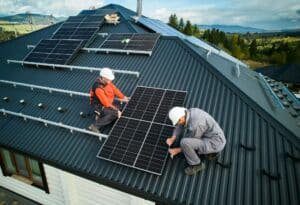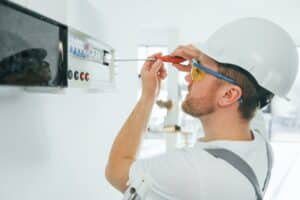Choosing the right wiring system for electrical installations is very important. It ensures the safety and efficiency of the electrical setup and makes sure it follows industry standards. This article will explain the environmental conditions you need to think about when picking a wiring system. It will help both homeowners and business owners make the best choice.
Why Environmental Conditions Matter
Environmental conditions are crucial when choosing a wiring system. According to Section 522 of BS 7671, the design of an electrical installation must consider the environmental conditions it will face. This ensures the wiring system stays safe, efficient, and lasts a long time.
Types of Environmental Conditions
Temperature Changes
Temperature changes can affect how well a wiring system works. Extreme hot or cold temperatures can damage the insulation, leading to short circuits or electrical fires. So, it’s important to choose wiring that can handle the temperature range of the installation area.
Humidity Levels
High humidity can cause condensation, which may lead to corrosion of the wiring and connectors. This is especially important in places like bathrooms, kitchens, or outdoor areas. Using moisture-resistant materials and proper sealing can help prevent these problems.
Chemical Exposure
In industrial settings, wiring systems may be exposed to chemicals that can damage the insulation and conductors. Choosing materials that resist chemical exposure is key to keeping the electrical system safe.
Mechanical Stress
Wiring systems in areas with mechanical stress, like vibrations or physical impacts, need to be strong and well-protected. This can be done by using armoured cables or extra protective coverings.
UV Radiation
Outdoor installations often face UV radiation, which can damage the insulation over time. Using UV-resistant materials can help ensure the wiring system lasts longer and stays safe.
Corrosive Environments
Places with high levels of salt or other corrosive substances, like coastal areas or industrial sites, need wiring systems that can resist corrosion. This often means using special coatings or materials.
Dust and Debris
Dust and debris can build up on wiring systems, causing overheating or short circuits. Proper enclosures and regular cleaning can help prevent these issues.
Vibration and Movement
In places with a lot of vibration or movement, like machinery or transportation systems, flexible and durable wiring solutions are needed to prevent damage and keep things running smoothly.
Fire Risk Areas
In areas with a high risk of fire, like kitchens or industrial sites, fire-resistant wiring is essential. This type of wiring can help stop the spread of fire and provide extra safety.
Water Exposure
Wiring systems in areas that might get wet, like outdoor installations or bathrooms, need to be waterproof or water-resistant. Proper sealing and using the right materials can prevent water from getting in and causing electrical hazards.
Choosing the Right Materials
Insulation Types
The type of insulation used in a wiring system can greatly affect its performance and durability. Common insulation materials include PVC, XLPE, and rubber. Each has its own advantages and limitations. The choice of insulation should be based on the specific environmental conditions and needs of the installation.
Conductor Materials
Copper and aluminium are the most commonly used conductor materials in wiring systems. Copper is known for its excellent conductivity and durability, while aluminium is lighter and more cost-effective. The choice between these materials depends on factors like load requirements, installation environment, and budget.
Protective Coverings
Protective coverings, like sheaths and conduits, provide an extra layer of protection for the wiring system. These coverings can protect against mechanical damage, chemical exposure, and environmental factors. The choice of protective covering should be based on the specific risks in the installation area.
Installation Methods
Surface Mounting
Surface mounting involves installing the wiring system on the surface of walls or ceilings. This method is often used in industrial settings or areas where frequent maintenance is needed. Surface mounting allows for easy access and inspection of the wiring system.
Concealed Wiring
Concealed wiring involves installing the wiring system within walls, ceilings, or floors. This method is commonly used in homes and commercial buildings for aesthetic reasons. Concealed wiring requires careful planning and installation to ensure safety and compliance with regulations.
Trunking and Conduits
Trunking and conduits provide a protective pathway for wiring systems. They are commonly used in commercial and industrial settings to organise and protect wiring. Trunking and conduits can be made from various materials, including metal and plastic, and should be chosen based on the specific environmental conditions.
Following Standards
BS 7671 Regulations
BS 7671, also known as the IET Wiring Regulations, provides comprehensive guidelines for electrical installations in the UK. Following these regulations is essential to ensure the safety and reliability of the wiring system. The regulations cover various aspects, including design, installation, and maintenance.
Local Building Codes
In addition to national standards, local building codes may have specific requirements for electrical installations. These codes can vary based on the location and type of building. It’s important to consult with local authorities and ensure compliance with all relevant codes and regulations.
Safety Tips
Regular Maintenance
Regular maintenance is crucial to ensure the continued safety and performance of the wiring system. This includes periodic inspections, testing, and repairs as needed. Proper maintenance can prevent potential hazards and extend the lifespan of the wiring system.
Professional Installation
Hiring a professional electrician for the installation of the wiring system is essential. Professional electricians have the knowledge and experience to ensure that the installation is done correctly and safely. They can also provide valuable advice on the best materials and methods for the specific installation environment.
FAQs
What are the key environmental conditions to consider when selecting a wiring system?
-
Key environmental conditions include temperature changes, humidity levels, chemical exposure, mechanical stress, UV radiation, corrosive environments, dust and debris, vibration and movement, fire risk areas, and water exposure.
Why is it important to consider environmental conditions in electrical installations?
-
Considering environmental conditions ensures the safety, efficiency, and durability of the wiring system. It also ensures compliance with industry standards and regulations.
What materials are commonly used for insulation in wiring systems?
-
Common insulation materials include PVC, XLPE, and rubber. Each material has its own set of advantages and limitations, and the choice should be based on the specific environmental conditions and requirements of the installation.
What are the benefits of using copper conductors in wiring systems?
-
Copper conductors offer excellent conductivity and durability. They are commonly used in wiring systems due to their reliability and performance.
How can I ensure compliance with BS 7671 regulations?
-
Ensuring compliance with BS 7671 regulations involves following the guidelines provided in the IET Wiring Regulations. This includes proper design, installation, and maintenance of the wiring system.
Why is regular maintenance important for wiring systems?
-
Regular maintenance is important to ensure the continued safety and performance of the wiring system. It helps prevent potential hazards and extends the lifespan of the system.
Conclusion
Selecting the right wiring system for an electrical installation involves careful consideration of various environmental conditions. By understanding and addressing these conditions, homeowners and business owners can ensure the safety, efficiency, and durability of their electrical systems. Compliance with industry standards and regulations, along with regular maintenance and professional installation, further enhances the reliability and performance of the wiring system.


